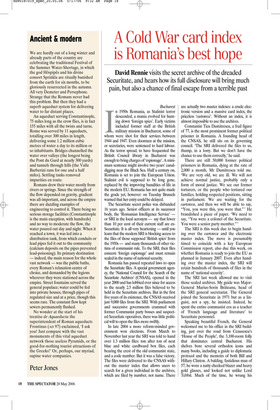Ancient & modern
We are hardly out of a long winter and already parts of the country are celebrating the traditional Festival of the Summer Water-Shortage, in which the god Hôspipês and his divine consort Sprinkla are ritually banished from the earth for six months, to be gloriously resurrected in the autumn. All very Demeter and Persephone. Strange that the Romans never had this problem. But then they had a superb aqueduct system for delivering water to far distant places.
An aqueduct serving Constantinople, 75 miles long as the crow flies, is in fact 155 miles with all the twists and turns. Rome was served by 11 aqueducts, totalling over 300 miles in length, delivering some 1.2 million cubic metres of water a day to its million or so inhabitants. Bridges channelled the water over valleys (the longest being the Pont du Gard at nearly 300 yards) and tunnels through hills (the Valle Barberini runs for one and a half miles). Settling tanks removed impurities en route.
Romans drew their water mostly from rivers or springs. Since the strength of the flow depended on gravity, gradient was all-important, and across the empire there are dazzling examples of engineering to control it. There being no serious storage facilities (Constantinople is the main exception, with hundreds) and no way to moderate the flow, the water poured out day and night. When it reached a town, it was led into a distribution tank, from which conduits or lead pipes fed it out to the community (calcium deposits on the pipes prevented lead-poisoning). Its primary destination — indeed, the main reason for the whole vast network — was the public baths, every Roman’s relaxation centre of choice, and demanded by the legions wherever they were stationed across the empire. Street fountains served the general populace; water could be fed into private houses, through pipes of regulated size and at a price, though this seems rare. The constant flow kept sewers permanently flushed.
No wonder at the start of his treatise de Aquaeductu the superintendent of Roman aqueducts Frontinus (AD 97) exclaimed, ‘I ask you! Just compare with the vast monuments of this vital aqueduct network those useless Pyramids, or the good-for-nothing tourist attractions of the Greeks!’ Or, perhaps, our myriad, supine water companies.


















































































 Previous page
Previous page